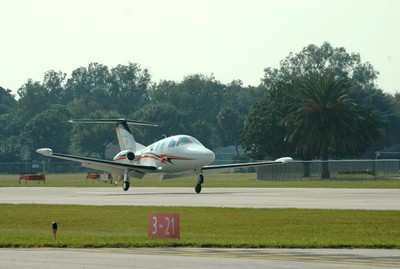Stresses EA500 Fleet Remains Fully Operational
 Eclipse Aviation announced Tuesday
it will incorporate design improvements to Eclipse 500 FADEC
software to prevent an engine fault that may occur if the
aircraft's throttle levers are advanced with enough force to exceed
the Eclipse 500's FAA-certified design limits.
Eclipse Aviation announced Tuesday
it will incorporate design improvements to Eclipse 500 FADEC
software to prevent an engine fault that may occur if the
aircraft's throttle levers are advanced with enough force to exceed
the Eclipse 500's FAA-certified design limits.
Eclipse intends to increase the range limit of the Throttle
Quadrant Assembly (TQA) to prevent the fault condition, pending
approval from the Federal Aviation Administration (FAA). These
changes will be administered via a software update to all Eclipse
500 owners and operators.
"One of the advantages to having such a technologically-advanced
aircraft is that we can quickly isolate the cause of an incident
and then rapidly deliver a solution to our customers via a
universal software update," said Vern Raburn, president and CEO of
Eclipse Aviation. "In contrast to traditional aviation industry
approaches, the time and customer inconvenience factor saved is
immeasurable."
As ANN reported, earlier this month an Eclipse
500 engine fault occurred during a landing at Chicago Midway
International Airport. N612KB (s/n 026) encountered windshear on
short final to land. The plane's pilot applied full power, using
enough force against the forward stops to exceed the design
throttle position signal maximum range. The associated fault mode
with the plane's FADEC held the engine thrust settings at the last
known throttle position -- full power.
Following the balked landing, the pilot elected to shutdown one
engine in order to reduce thrust. After spooling down the right
engine, however, the left-side turbofan reduced thrust to idle...
and failed to respond to subsequent throttle inputs. Fortunately,
the pilot was able to perform a safe emergency landing at MDW, with
two blown maingear tires the only damage to plane and crew.
Through analysis of the incident aircraft's advanced data
collection and reporting system, Eclipse determined the fault was
generated by an exceedance of the Eclipse 500's FAA-certified
design limits. The company says it took immediate steps to notify
owners of the issue, but the NTSB and FAA acted on the problem as
well.
In compliance with
an Emergency Airworthiness Directive from the
FAA, pilots were told to inspect the throttle
quadrants on their aircraft before further flight, and to place
updated procedures pages in the Eclipse 500 flight manual and quick
reference handbook to provide guidance on how to handle a similar
incident.
Eclipse also announced that of all the Eclipse 500 aircraft in
customer operation -- 207 planes, according to the FAA -- over 80
percent have been inspected as directed by the AD. Of this group of
inspected aircraft, seven have reported fault errors. Four of the
seven reported faults were determined to be erroneous due to noise
caused by normal operation of the TQA.

"Interestingly, an analysis of more than 12,000 hours of flight
data from across our fleet collected through the Eclipse Flight
Operational Quality Assurance (FOQA) system reveals that three
Eclipse 500 aircraft have experienced the TQA range exceedance
fault, and one was the aircraft in Chicago," said Raburn. "While
this tells us there is an extremely low probability of this fault
happening, we are moving very aggressively to ensure it will not
occur again. We're working closely with both the staff members of
the NTSB and the FAA to understand this condition fully, and put
the necessary design improvements in place to safeguard our
customers and our fleet."
 ANN's Daily Aero-Linx (04.17.24)
ANN's Daily Aero-Linx (04.17.24) ANN's Daily Aero-Term (04.17.24): Jamming
ANN's Daily Aero-Term (04.17.24): Jamming ANN's Daily Aero-Linx (04.18.24)
ANN's Daily Aero-Linx (04.18.24) Aero-News: Quote of the Day (04.18.24)
Aero-News: Quote of the Day (04.18.24) ANN's Daily Aero-Term (04.18.24): Hold-In-Lieu Of Procedure Turn
ANN's Daily Aero-Term (04.18.24): Hold-In-Lieu Of Procedure Turn




